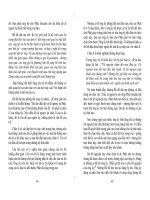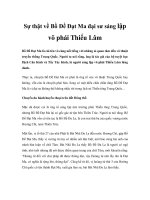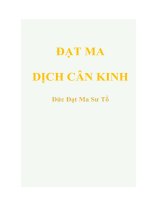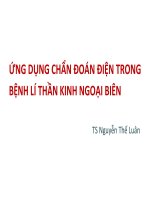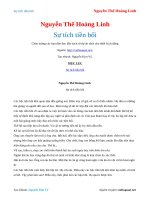ĐẠT MA TỔ SƯ LUẬN - BIÊN TẬP: NGUYỄN THẾ VINH
Bạn đang xem bản rút gọn của tài liệu. Xem và tải ngay bản đầy đủ của tài liệu tại đây (1.85 MB, 256 trang )
ĐẠT MA TỔ SƯ LUẬN
1
HỘI LUẬT GIA VIỆT NAM
NHÀ XUẤT BẢN HỒNG ĐỨC
Địa chỉ: 65 Tràng Thi, Quận Hoàn Kiếm, Hà Nội
Email:
Điện thoại: 04.39260024 Fax: 04.39260031
Chịu trách nhiệm xuất bản
Giám đốc Bùi Việt Bắc
Biên tập: Nguyễn Thế Vinh
Trình bày bìa: Ngọc Bảo
Liên kết xuất bản
Thiền viện Thường Chiếu
In 3.000 cuốn, khổ 14.5 x 20.5 cm
Tại Công ty Cổ phần In Khuyến Học Phía Nam.
Số 9-11 Đường CN1, P.Sơn Kỳ, Q.Tân Phú, Tp.HCM - ĐT: (08) 38.164.415.
Số đăng ký KHXB:1049-2014/CXB/18-29/HĐ.
QĐXB: 958-2014/QĐ-HĐ. Ký ngày 31/05/2014.
ISBN: 978-604-86-2195-7
In xong nộp lưu chiểu quý III năm 2014
ĐẠT MA TỔ SƯ LUẬN
THE ZEN TEACHING of
BODHIDHARMA
Compiled by Thích Nữ Thuần Bạch
NHÀ XUẤT BẢN HỒNG ĐỨC
3
INTRODUCTION
This bi-lingual text of the Zen Teaching of
Bodhidharma has been prepared for my English-speaking
students and for the young generation of Vietnamese
students of the Dharma. It is part of our ongoing program
to present bi-lingual, contemporary versions of the classic
texts of Zen Buddhism.
I would like to express my deep gratitude to Red
Pine for graciously giving us permission to use his English
translation, from the Chinese, of the Zen Teaching of
Bodhidharma.
The Vietnamese translation and commentaries are
from my headmaster, the Most Venerable Thích Thanh
Từ. I have translated his commentaries and added my
own, in English and Vietnamese.
I wish to thank my sisters in the convent for
proofreading the Vietnamese text and for helping me
check the Chinese characters.
The merits of this work are dedicated to all Zen
practitioners.
Thích Nữ Thuần Bạch
4
LỜI ĐẦU SÁCH
Quyển Đạt-ma Tổ Sư Luận song ngữ này được soạn
thảo cho lớp Phật pháp tiếng Anh và cho giới trẻ người
Việt học Phật. Đây là một phần việc trong chương trình
giới thiệu những bản dịch hiện nay về văn bản Thiền cổ
điển.
Tôi xin chân thành cảm tạ dịch giả Red Pine đã hoan
hỷ cho phép xử dụng bản dịch Anh ngữ The Zen Teaching
of Bodhidharma của ông từ nguyên văn chữ Hán
Bản dịch Việt ngữ và giảng giải tôi xin phép được
xử dụng của Hịa Thượng Ân Sư Thích Thanh Từ. Tơi
đã dịch lời giảng của Hịa Thượng sang tiếng Anh và có
thêm vài phụ chú.
Tôi cũng xin cảm ơn quý Sư Cô huynh đệ trong chùa
đã tận tình giúp đỡ dị lỗi đánh máy tiếng Việt và xem lại
nguyên văn chữ Hán.
Xin hồi hướng cơng đức hồn thành quyển sách này
cho tất cả những người học và tu thiền.
Thích Nữ Thuần Bạch
5
6
ĐẠT MA TỔ SƯ LUẬN
THE ZEN TEACHING
of
BODHIDHARMA
Vietnamese version:
Zen Master Thích Thanh Từ
English version & Foot Notes:
Red Pine
Footnotes translated in Vietnamese:
Thuần Bạch
7
8
May 7, 2010
Dear Mr. Red Pine,
I am Reverend Thich Nu Thuan Bach, abbess of Dieu
Nhan Zen Convent, in Rescue, California. I am preparing
a bi-lingual text of the Zen teaching of Bodhidharma for
my dharma lessons and for the use of my Vietnamese and
American students.
I have rearranged the content of Bodhidharma’s
three sermons into subject areas, such as Meritorious
Works, True Seeing, Beholding the Mind, etc., in order
to simplify my presentation and to encourage discussion
among my students.
The Vietnamese translation, from the original
Chinese text, is by Zen Master Thich Thanh Tu.
I would like permission to use your translation of
the Bloodstream Sermon, the Wake-up Sermon, and the
Breakthrough Sermon for the English half of the text for
my classes.
9
This bi-lingual text will be printed in a limited
quantity. It will be used by monks and nuns in Zen
monasteries in Vietnam and the United States, as well as
by my student groups. These books will be distributed
at no charge, as the lay community of our convent has
donated the funds to have them printed.
I hope that you will allow me to use your translation,
so that I may proceed with printing arrangements. Your
help is precious, as it will enable us to complete our task
and to expound the teachings of Bodhidharma here and
in Vietnam. This is also in accordance with the vows of
all Buddhist authors to promulgate the Dharma and to
enable large numbers of people to read the scriptures.
I appreciate being introduced to you by Doan Trang
and I thank you for your assistance.
Sincerely,
Thich Nu Thuan Bach
10
Dear Thich Nu Thuan Bach,
I received a copy of your Vietnamese translation of
Bodhidharma on Friday. It’s looks great! I wish there
were more bi-lingual books like this for Asian and Western
Buddhists to use. When I first started studying Buddhism,
I had to have two different books, one with English and
one with Chinese. Putting them together makes so much
sense. Congratulations! I hope your fellow nuns and
practitioners find this book useful.
Bodhidharma’s voice is so clear and so
straightforward. He was a great teacher. Sometimes
Buddhism becomes too complicated. When it does, it’s
always good to read a book like this.
Thanks again for sending me a copy. I also look
forward to visiting your convent some day in the future.
Yours,
Bill Porter
11
OUTLINE of PRACTICE
1. Many roads lead to the Path, but basically there
are only two: reason and practice.
To enter by reason means to realize the essence
through instruction and to believe that all living things
share the same true nature, which isn’t apparent because
it’s shrouded by sensation and delusion. Those who turn
from delusion back to reality, who meditate on walls1,
the absence of self and other, the oneness of mortal and
sage, and who remain unmoved even by scriptures are in
complete and unspoken agreement with reason. Without
moving, without effort, they enter, we say, by reason.
2. To enter by practice refers to four all-inclusive
practices2: suffering injustice, adapting to conditions,
seeking nothing, and practicing the Dharma.
1 Walls. After he arrived in China, Bodhidharma spent
nine years in meditation facing the rock wall of a cave near
Shaolin Temple. Bodhidharma’s walls of emptiness connect
all opposites, including self and other, mortal and sage.
2 Four... practices. These are a variation of the Four
Noble Truths: all existence is marked by suffering; suffering
has a cause; the cause can be brought to an end; and the way
to bring it to an end is the Eightfold Noble Path of right views,
right thought, right speech, right action, right livelihood, right
devotion, right mindfulness, and right zen.
12
NHỊ CHỦNG NHẬP
1. Vào đạo có nhiều đường nhưng cốt yếu thì chỉ có
hai đường chính là lý nhập và hạnh nhập.
LÝ NHẬP là nương nơi giáo để ngộ được tông. Tin
sâu chúng sanh đồng có một chân tánh, chỉ vì khách trần
và vọng tưởng che lấp nên không thể hiển bày. Nếu bỏ
vọng về chân, ngưng trụ nhìn vách1 thì khơng thấy có ta
có người, phàm thánh đồng một, kiên trụ không dời đổi.
Lại không tùy theo văn giáo, tức phù hợp với lý, khơng có
phân biệt và lặng lẽ vơ vi, gọi đó là lý nhập.
2. HẠNH NHẬP là nói về bốn hạnh2: báo ốn hạnh,
tùy dun hạnh, vô sở cầu hạnh và xứng pháp hạnh.
1 Sau khi đến Trung Hoa, tổ Đạt-ma ngồi chín năm
quay mặt vào vách đá (cửu niên diện bích) trong một hang
động trên núi Thiếu Lâm. Pháp tu này còn gọi là “ngưng trụ
bích qn,” tức là khơng phân biệt đối đãi, kể cả ngã/nhân,
thiện/ác.
2 Bốn hạnh này là biến thể của Tứ Diệu Đế: 1/ Khổ, 2/
Tập, 3/Diệt và 4/Đạo đế, tức Bát thánh đạo gồm: chánh kiến,
chánh tư duy, chánh ngữ, chánh nghiệp, chánh mạng, chánh
tinh tấn, chánh niệm và chánh định.
13
3. First, suffering injustice.
When those who search for the Path encounter
adversity, they should think to themselves, “In countless
ages gone by, I’ve turned from the essential to the
trivial and wandered through all manner of existences,
and I have often been angry without cause and guilty
of transgressions without number. Now, though I do no
wrong, I’m punished by my past. Neither gods nor men
can foresee when an evil deed will bear its fruit. I accept
it with an open heart and without complaint of injustice.”
The sutras say, “When you meet with adversity don’t be
upset, because it makes sense.” With such understanding
you’re in harmony with reason. And by suffering injustice
you enter the Path.
4. Second, adapting to conditions.
As mortals, we’re ruled by conditions, not by
ourselves. All the suffering and joy we experience depend
on conditions. If we should be blessed by some great
reward, such as fame or fortune, it’s the fruit of a seed
planted by us in the past. When conditions change, it
ends. Why delight in its existence? But while success and
failure depend on conditions, the mind neither waxes
nor wanes. Those who remain unmoved by the wind of
joy silently follow the Path.
5. Third, seeking nothing.
People of this world are deluded. They’re always
longing for something - always, in a word, seeking.
14
3. Báo Oán Hạnh
Người tu hành khi gặp cảnh khổ phải tự nghĩ rằng:
“Ta từ xưa đến giờ trong vô số kiếp bỏ gốc theo ngọn,
nên trơi lăn trong các cõi, khởi lịng ốn ghét căm hận vơ
hạn. Ðời nay tuy khơng có phạm những tội lỗi ấy, nhưng
nghiệp ác gieo đời trước nay kết trái chín. Việc này khơng
phải do trời hoặc người tạo ra cho mình, vậy ta phải cam
nhận chịu, khơng ốn trách.” Kinh nói: “Gặp khổ khơng
buồn.” Vì cớ sao? Vì khi tâm [sanh hiểu như thế] sẽ phù
hợp với lý. Mượn gốc oán thù để tiến vào đạo nên nói là
hạnh báo ốn.
4. Tùy Dun Hạnh.
Chúng sanh khơng có ngã tùy dun nghiệp mà
chuyển thành. Đồng thọ khổ vui đều từ duyên sanh. Nếu
được quả báo thù thắng, đầy đủ vinh dự là do nhân lành
đời trước mới được như thế. Khi duyên hết rồi thì cũng trở
thành khơng. Có gì phải mừng? Ðược mất đều tùy theo
dun, tâm khơng vì vậy mà được thêm hoặc bớt mất.
Như vậy ngọn gió hỉ chẳng làm động tâm, hằng thuận với
đạo, nên nói là hạnh tùy duyên.
5. Vô Sở Cầu Hạnh
Người đời hằng ở trong mê, mỗi chỗ đều có tham
trước nên gọi là cầu.
15
But the wise wake up. They choose reason over
custom. They fix their minds on the sublime and let their
bodies change with the seasons. All phenomena are
empty. They contain nothing worth desiring. Calamity
forever alternates with Prosperity3. To dwell in the three
realms4 is to dwell in a burning house. To have a body is
to suffer. Does anyone with a body know peace? Those
who understand this detach themselves from all that
exists and stop imagining or seeking anything. The sutras
say, “To seek is to suffer. To seek nothing is bliss.” When
you seek nothing, you’re on the Path.
6. Fourth, practicing the Dharma5.
The Dharma is the truth that all natures are pure.
By this truth, all appearances are empty.
3 Calamity... Prosperity. Two goddesses, responsible for
bad and good fortune, respectively. They appear in Chapter
Twelve of the Nirvana Sutra.
4 Three realms. The Buddhist psychological equivalent
of the Brahmanic cosmological triple world of bhur, bhuvah, and
svar, or earth, atmosphere, and heaven. The Buddhist triple
world includes kamadhatu, or the realm of desire-the hells,
the four continents of the human and animal world, and the six
heavens of pleasure; rupadhatu, or the realm of form-the four
heavens of meditation; and arupadhatu, or the formless realm
of pure spirit-the four empty or immaterial states. Together,
the three realms constitute the limits of existence. In Chapter
Three of the Lotus Sutra the three realms are represented by
a burning house.
5 Dharma. The Sanskrit word dharma comes from
dhri, meaning to hold, and refers to anything held to be real,
whether in a provisional or in an ultimate sense. Hence, the
word can mean thing, teaching, or reality.
16
Người trí ngộ được lẽ chân, lý ngược với thế tục,
nên tâm an trụ ở vơ vi mặc cho thân hình tùy nghi vận
chuyển. Vạn hữu đều khơng, có gì đáng mong thích? Hễ
có ông Thiện liền có ông Ác kế bên3. Ở lâu trong ba cõi4
vẫn như trong nhà lửa. Có thân đều là khổ, được gì mà an
vui. Rõ suốt được chỗ này nên bỏ các hữu, dứt nghĩ tưởng
mong cầu. Kinh nói “Cịn cầu đều khổ, khơng cầu mới an
vui.” Nên biết khơng cầu mới thực là đạo hạnh, nên nói là
hạnh vô sở cầu.
6. Xứng Pháp Hạnh5.
Lý tánh thanh tịnh gọi là Pháp. Tin hiểu lý này thì tất
cả tướng đều khơng.
3 Ơng Ác và ông Thiện là hai vị thần hộ pháp trong
chương 12 kinh Niết-bàn.
4 Ba cõi theo đạo Phật gồm có:
1/ dục giới - địa ngục, bốn châu của cõi người và súc sanh, và
sáu tầng trời dục giới; 2/ sắc giới – bốn tầng thiền định; 3/ vô
sắc giới – tứ không.
Trong chương 3 kinh Pháp Hoa ba cõi được tượng trưng
bằng nhà lửa.
5 Chữ “pháp” tiếng Phạn là dharma từ chữ dhri, có
nghĩa nắm giữ, và chỉ cho lẽ thật, cả nghĩa tương đối (phương
tiện) lẫn tuyệt đối (cứu cánh).
17
Defilement and attachment, subject and object
don’t exist. The sutras say, “The Dharma includes no
being because it’s free from the impurity of being, and
the Dharma includes no self because it’s free from the
impurity of self.”
Those wise enough to believe and understand this
truth are bound to practice according to the Dharma.
And since that which is real includes nothing worth
begrudging, they give their body, life, and property
in charity, without regret, without the vanity of giver,
gift, or recipient, and without bias or attachment. And
to eliminate impurity they teach others, but without
becoming attached to form. Thus, through their own
practice they are able to help others and glorify the Way
of Enlightenment.
And as with charity, they also practice the other
virtues. But while practicing the six virtues6 to eliminate
delusion, they practice nothing at all. This is what’s meant
by practicing the Dharma.
*
6 Six virtues. The paramitas, or means to the other
shore: charity, morality, patience, devotion, meditation, and
wisdom. All six must be practiced with detachment from the
concepts of actor, action, and beneficiary.
18
Không nhiễm không trước, không đây (chủ thể)
không kia (đối tượng). Kinh [Duy-ma-cật] nói: “Pháp
khơng có chúng sanh vì lìa cấu uế của chúng sanh. Pháp
khơng có tướng ngã vì lìa cấu uế của ngã.”
Người trí tin hiểu được lý này nên nói xứng với pháp
mà hành. Pháp thể vốn không xan tham nên đối với thân
mạng và tiền của thực hành hạnh bố thí tâm khơng tiếc
lẫn. Thấu suốt ba lẽ không – [người cho, của cho và người
nhận] - thì khơng nương khơng mắc. Chỉ cần dẹp bỏ trần
cấu, giáo hóa xứng hợp chúng sanh mà không chấp tướng
đây là tự hành. Đã làm lợi người lại thêm trang nghiêm
đạo Bồ-đề.
Năm độ khác cùng với bố thí cũng như vậy. Vì trừ
vọng tưởng tu hành lục độ6, mà khơng có sở hành, nên nói
là xứng pháp hạnh.
*
6 Lục độ, còn gọi là lục ba-la-mật, là sáu pháp đưa qua
bờ giác ngộ bên kia: bố thí, trì giới, nhẫn nhục, tinh tấn, thiền
định và trí tuệ. Thực hành cả sáu pháp mà khơng dính mắc
vào ý niệm người hành động, việc hành động và người thọ
hưởng.
19
BLOODSTREAM SERMON
7. Everything that appears in the three realms
comes from the mind7. Hence, Buddhas8 of the past have
taught and future Buddhas teach mind to mind without
bothering about definitions9.
8. But if they don’t define it, what do they mean by
mind?
9. You ask. That’s your mind. I answer. That’s my
mind. If I had no mind, how could I answer? If you had no
mind, how could you ask? That which asks is your mind.
Through endless kalpas10 without beginning, whatever
you do, wherever you are, that’s your real mind that’s
your real buddha.
7 Mind. A verse from the Avatamsaka Sutra is
paraphrased here: “The three realms are just one mind.” The
sixth Zen patriarch, Hui-neng, distinguishes mind as the realm
and nature as the lord.
8 Buddhas. Buddhism doesn’t limit itself to one buddha.
It recognizes countless buddhas. After all, everyone has the
buddha-nature. There’s a buddha in every world, just as there’s
awareness in every thought. The only necessary qualification
for buddhahood is complete awareness.
9 Without definitions. The absence of definitions or
explanations in the transmission of the Dharma is a touchstone
of Zen Buddhism. It doesn’t necessarily mean without words
but, rather, without restrictions as to the mode of transmission.
A gesture is as good as a discourse.
10 Kalpa. The period from a world’s creation until its
destruction; an aeon.
20

